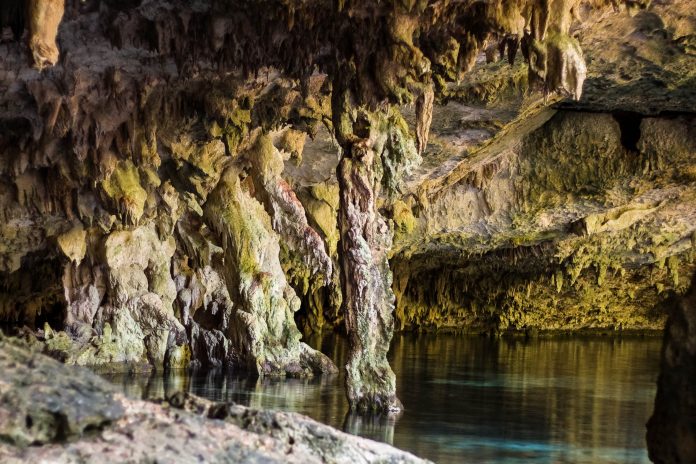Die Dos Ojos sind eines von mehreren Unterwasserhöhlen-Systemen in Mexiko und für Höhlentaucher ein absolut unvergessliches Erlebnis! Allein im Bundesstaat Quintana Roo beträgt die Gesamtlänge der erforschten Höhlen an die 1.000 Kilometer.
Dos Ojos bedeutet übersetzt „Zwei Augen“ und bezeichnet eine weltweit einzigartige Sehenswürdigkeit in Mexiko, die auch auf unserer Liste der Top 10 Sehenswürdigkeiten von Mexiko steht. Das bei Tauchern äußerst beliebte Höhlensystem der Dos Ojos hat eine Länge von etwa 82km, vereint 28 so genannte „Cenoten“ und ist damit nach Sistema Ox Bel Ha und Sistema Sac Actun das drittgrößte Unterwasserhöhlensystem der Welt.
Letzteres ist in seinem geringsten Abstand nur 6 Meter von den Dos Ojos entfernt. Im August 2012 wurde eine Verbindung zwischen den Dos Ojos und dem Sac Actun entdeckt, die über eine trockene Passage führt. Damit erreicht das Höhlensystem Sac Actun/Dos Ojos sogar eine länge von 311km, was es nach der Mammoth Cave im US-Bundesstaat Kentucky zur zweitlängsten Höhle der Welt macht.
Im Jänner 2018 haben Forscher schließlich auch eine unterirdische Verbindung gefunden. Dos Ojos und Sac Actun bilden damit das größte derartige Höhlensystem der Erde.
Was sind Cenoten?

Cenoten sind dolinen-ähnliche Kalksteinlöcher im Boden, die durch den Einsturz von Höhlen entstanden sind. Im Gegensatz zu den Dolinen, die man als Landabsenkungen aus dem Gebirge kennt, sind die Cenoten jedoch mit Süßwasser gefüllt und haben somit unglaubliche Unterwasserwelten erschaffen.
Die meisten Cenoten in Mexiko befinden sich wie die Dos Ojos im Bundesstaat Quintana Roo, dies sind etwa 900 an der Zahl. Auch auf der Halbinsel Yucatan und über der mexikanischen Grenze in Belize finden sich einige dieser Einstiegslöcher in eine andere Welt. Die Cenote Ik-Kil gehört zu den bekanntesten unter ihnen. Allein in Quintana Roo beträgt die Gesamtlänge der erforschten Höhlen an die 1.000 Kilometer.
Durchschnittlich sind die Unterwasserhöhlen etwa 15 Meter tief, es gibt aber Rekordhalter mit einer Tiefe von bis zu 100 Meter. Die Maya sahen in ihnen Eingänge zur Unterwelt und nutzten die scheinbar bodenlosen Löcher im Boden als Opferstätten. Für die Maya hatten die Cenoten jedoch auch einen überlebenswichtigen Nutzen. Wie jede frühe Hochkultur waren auch sie von der Wasserversorgung abhängig, die durch die Cenoten gewährleistet war.
Was für andere Kulturen der Nil, Euphrat oder Ganges war, war für die Maya diese Unterwasserwelt, die daher auch „Großer Strom der Maya“ genannt wird. Auch die trotz Dürre üppige Vegetation auf der Halbinsel Yucatan führen Wissenschaftler auf dieses verborgene Bewässerungssystem zurück. Als oft einzige Wasserquelle während der heißen Trockenzeiten ziehen sie auch immer wieder eine Vielzahl von Tieren an ihre Ufer.
Tauchen in den Dos Ojos
Als Taucher ist der Besuch der Dos Ojos ein wahrlich unvergessliches Erlebnis! Man hat das Gefühl, als schwebe man in 25°C warmen Wasser durch die bizarre Welt einer Tropfsteinhöhle. In der „Fledermaushöhle“ geht es an bizarren Stalaktiten vorbei oder durch eine kleine Öffnung in den fantastisch anmutenden „Schicksalstempel“ (Temple of Doom) mit seinen engen Passagen und großartigen Felsformationen.
Die Sicht ist fantastisch, man schließt Bekanntschaft mit einer Vielzahl von anderen Bewohnern. Sumpfschildkröten, Buntbarsche, Spitzmaulkärpflinge, Antennenwelse sowie verschiedenen Grundeln und Salmler fühlen sich dort pudelwohl. In den mexikanischen Cenoten lebt unter anderem der blinde Höhlensalmler, der nur im Bundesstaat San Luis Potosí vorkommt, und hier auch nur in drei verschiedenen Höhlen.
Achtung: Tauchen in den Cenoten kann lebensgefährlich sein! Freiwasser-Taucher ohne Höhlenerfahrung sollten auf keinen Fall ohne vorherige Instruktionen in die Cenoten absteigen! Bei Schwierigkeiten kann man nicht einfach auftauchen, sondern ist in der Höhle gefangen. Man muss den Weg zurücktauchen, was bis zu mehreren Kilometern sein kann. Deshalb unbedingt mehr Sauerstoff als geplant benötigt mitnehmen, am besten die doppelte Menge in verschiedenen Tanks. Manche Höhlen sind wie ein Labyrinth, deshalb den markierten Pfaden folgen. In unerforschtem Gebiet kann man sich leicht verirren bzw. können die Höhlendecken leicht einstürzen. Mehrere Taschenlampen einstecken und die altbekannte Taucherregel in jedem Fall berücksichtigen: NIE alleine tauchen!
Betrachtet man die Cenoten Dos Ojos aus der Luft lässt sich ein beinahe perfekter halbkreisförmiger Ring erkennen. Forscher gehen davon aus, dass diese Brüche in der unterirdischen Landschaft den Kraterrand vom Einschlag des berühmten Chixculub Meteoriten vor rund 65 Millionen Jahren ausmachen – derjenige Meteorit, der auch mit dem Aussterben der Dinosaurier in Verbindung gebracht wird.





